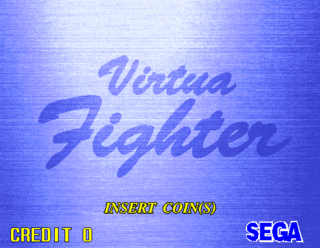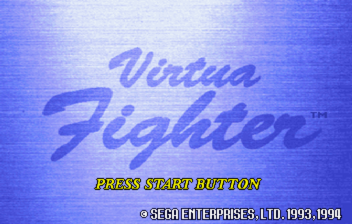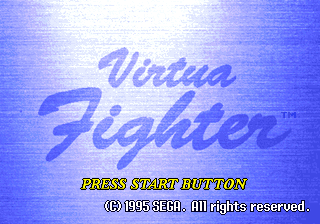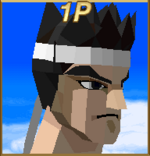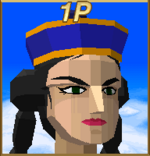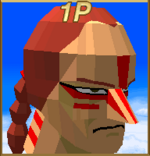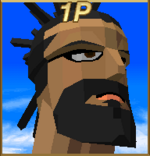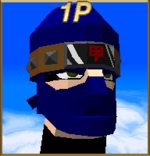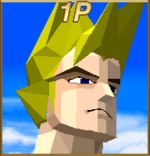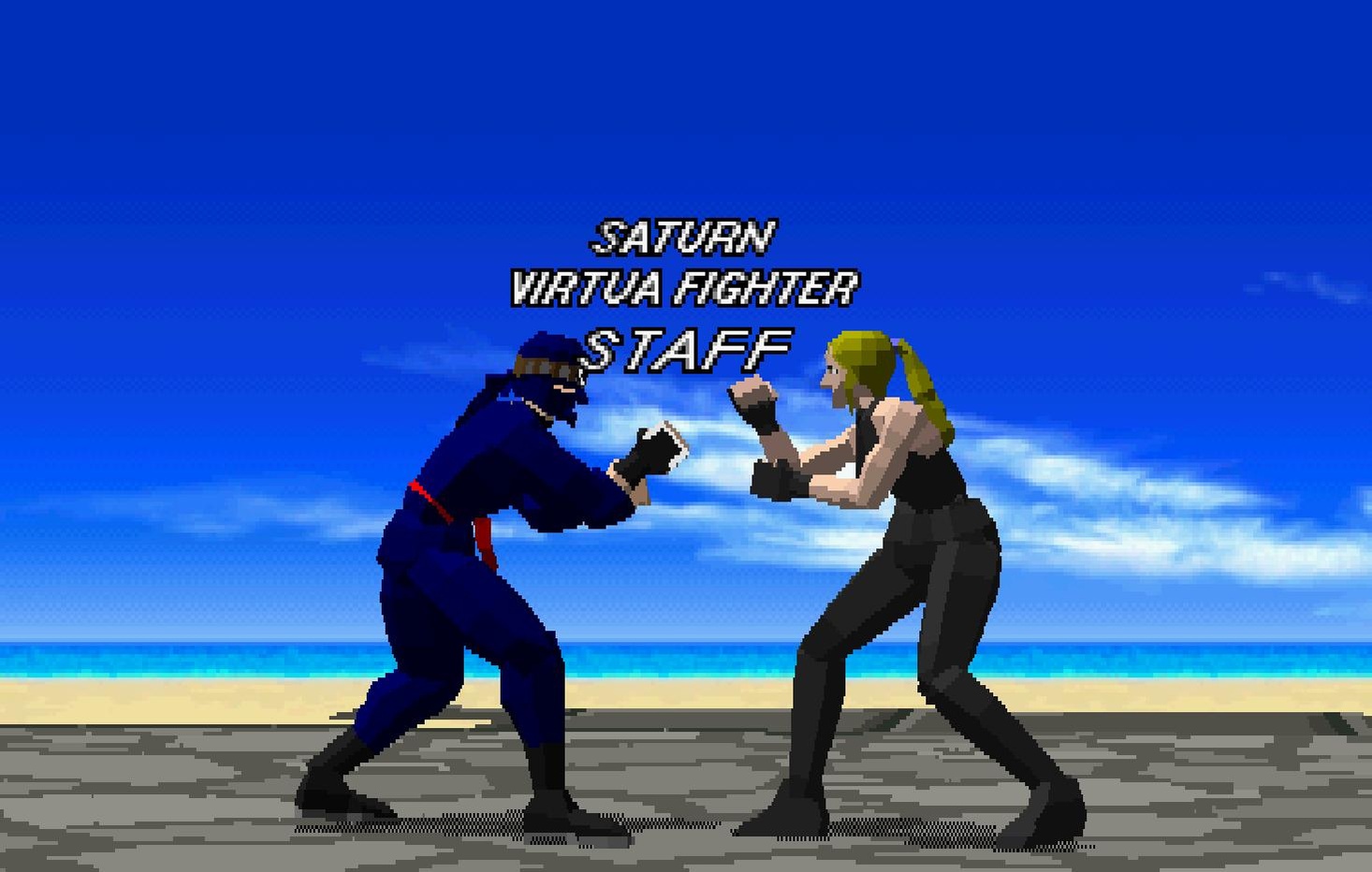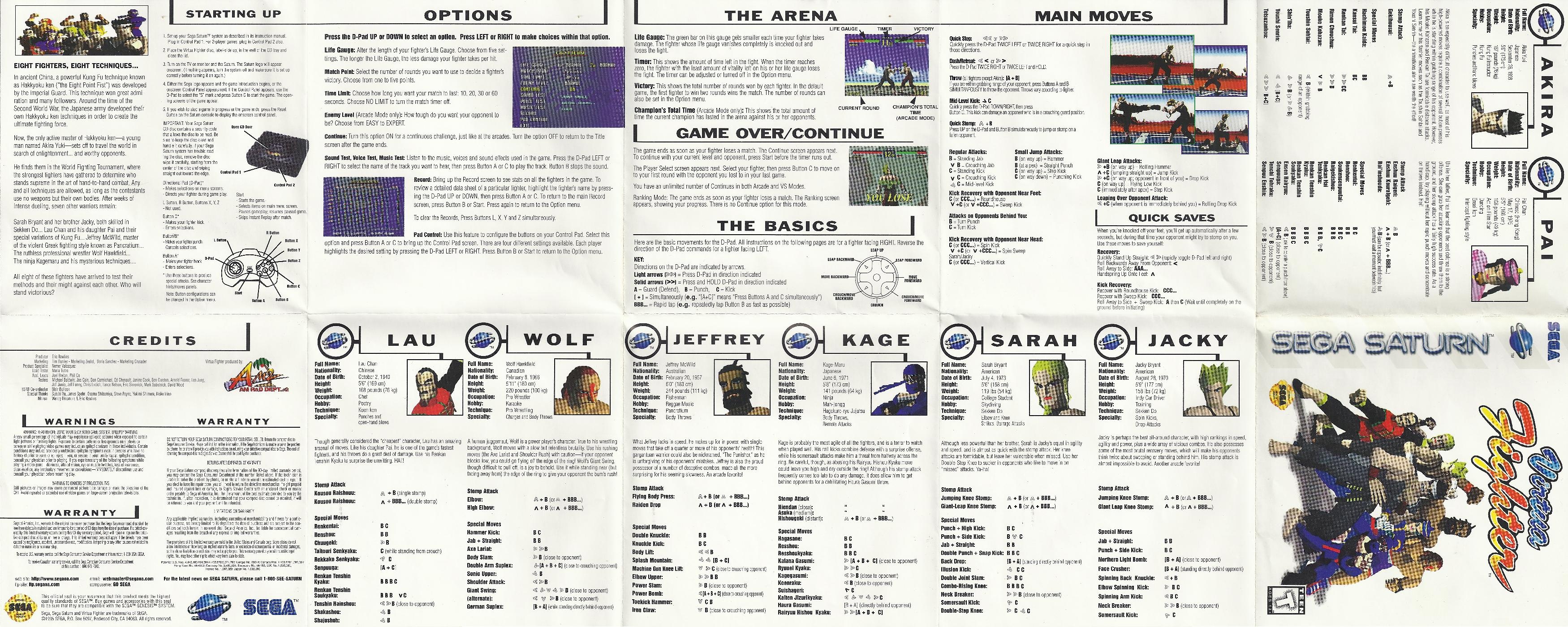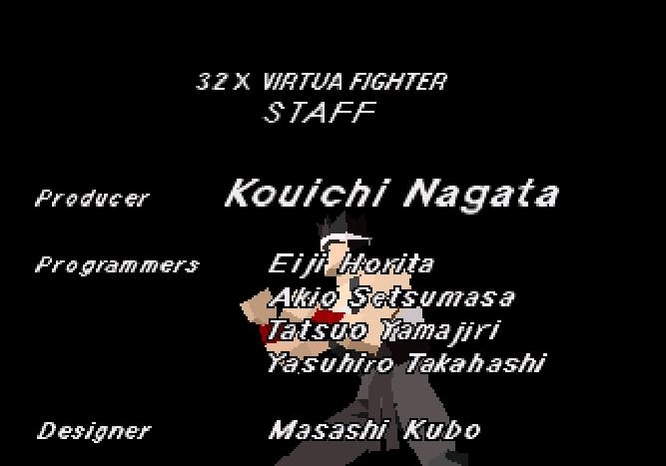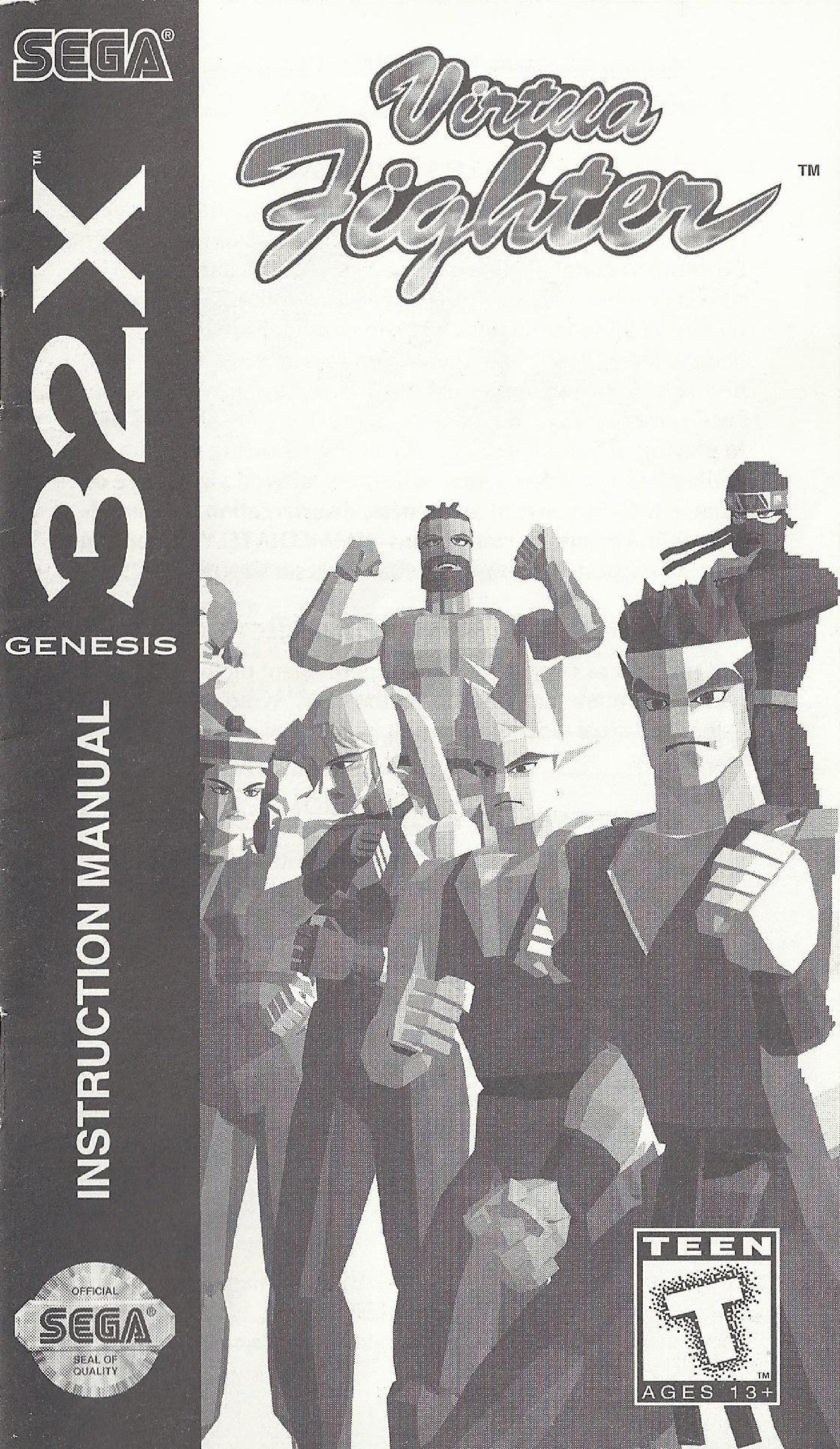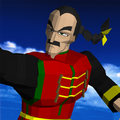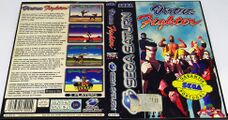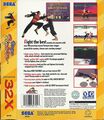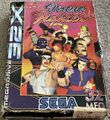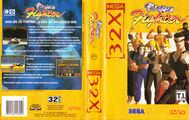Difference between revisions of "Virtua Fighter"
From Sega Retro
Bonus Game (talk | contribs) (→Gameplay: added Quick Recovery section and added some extra descriptions) |
Bonus Game (talk | contribs) |
||
| Line 149: | Line 149: | ||
{{MoveListTable|desc=down attacks| | {{MoveListTable|desc=down attacks| | ||
{{MoveListRow|Gekihousui|{{up}} {{punch}} }} | {{MoveListRow|Gekihousui|{{up}} {{punch}} }} | ||
| − | {{MoveListRow|Soukahou (槍下炮)|{{downright}} {{punch}}|The move can be repeated indefinitely, but players must wait a moment between hits.}} | + | {{MoveListRow|Soukahou (槍下炮)|{{downright}} {{punch}} near the knocked down opponent|The move can be repeated indefinitely, but players must wait a moment between hits.}} |
}} | }} | ||
{{MoveListTable|desc=special moves| | {{MoveListTable|desc=special moves| | ||
| − | {{MoveListRow|Renkantai (連環腿)|{{right}}{{right}} {{kick}}{{kick}}|Akira performs a forward hopping double kick attack. If the move is performed with just one kick button press ({{right}}{{right}} {{kick}}), Akira will perform just a single forward hop kick. Its possible to input the command for this move while holding the guard button.}} | + | {{MoveListRow|Renkantai (連環腿)|{{right}}{{right}} {{kick}}{{kick}}|Akira performs a forward hopping double kick attack. If the move is performed with just one kick button press ({{right}}{{right}} {{kick}}), Akira will perform just a single forward hop kick (Utankyaku). Its possible to input the command for this move while holding the {{guard}} button.}} |
{{MoveListRow|Tetsuzankou (鉄山靠)|{{left}}{{right}}{{right}} {{punch}}+{{kick}} }} | {{MoveListRow|Tetsuzankou (鉄山靠)|{{left}}{{right}}{{right}} {{punch}}+{{kick}} }} | ||
{{MoveListRow|Toushin Soutai (倒身捜腿)|{{left}} {{punch}} (close to opponent)|Akira grabs the opponent and trips them with his leg.}} | {{MoveListRow|Toushin Soutai (倒身捜腿)|{{left}} {{punch}} (close to opponent)|Akira grabs the opponent and trips them with his leg.}} | ||
| Line 166: | Line 166: | ||
{{MoveListRow|Enshuu Raigeki|{{up}} {{punch}} }} | {{MoveListRow|Enshuu Raigeki|{{up}} {{punch}} }} | ||
{{MoveListRow|Enshuu Kouraigeki|{{Hold|{{up}}|{{punch}}}} }} | {{MoveListRow|Enshuu Kouraigeki|{{Hold|{{up}}|{{punch}}}} }} | ||
| − | {{MoveListRow|Rai'inshouda (雷陰掌打)|{{downright}} {{punch}}|The move can be repeated indefinitely, but players must wait a moment between hits.}} | + | {{MoveListRow|Rai'inshouda (雷陰掌打)|{{downright}} {{punch}} near the knocked down opponent|The move can be repeated indefinitely, but players must wait a moment between hits.}} |
}} | }} | ||
{{MoveListTable|desc=special moves| | {{MoveListTable|desc=special moves| | ||
{{MoveListRow|Senpuuga (旋風牙)|{{kick}}+{{guard}}|Same technique as Lau's.}} | {{MoveListRow|Senpuuga (旋風牙)|{{kick}}+{{guard}}|Same technique as Lau's.}} | ||
{{MoveListRow|Ensen Shuu|{{Hold|{{down}}|{{kick}}+{{guard}}}}|Same technique as Lau's.}} | {{MoveListRow|Ensen Shuu|{{Hold|{{down}}|{{kick}}+{{guard}}}}|Same technique as Lau's.}} | ||
| − | {{MoveListRow|Taitou Risenkyaku|Press {{kick}} while standing up from crouch|Pai performs a forward advancing roundhouse kick that knocks down the opponent.}} | + | {{MoveListRow|Taitou Risenkyaku|Press {{kick}} while standing up from crouch|Pai performs a forward advancing roundhouse kick that knocks down the opponent. Same technique as Lau's.}} |
{{MoveListRow|Tenshin Soutou (転身捜倒)|{{punch}}+{{guard}} (close to opponent)|Normal throw technique.}} | {{MoveListRow|Tenshin Soutou (転身捜倒)|{{punch}}+{{guard}} (close to opponent)|Normal throw technique.}} | ||
{{MoveListRow|Tenchi Touraku|{{right}}{{down}} {{punch}} (close to opponent)|DDT-like throw technique.}} | {{MoveListRow|Tenchi Touraku|{{right}}{{down}} {{punch}} (close to opponent)|DDT-like throw technique.}} | ||
| Line 220: | Line 220: | ||
{{MoveListRow|Jab + Straight|{{punch}}{{punch}} }} | {{MoveListRow|Jab + Straight|{{punch}}{{punch}} }} | ||
{{MoveListRow|Hammer Kick|{{punch}}{{kick}} }} | {{MoveListRow|Hammer Kick|{{punch}}{{kick}} }} | ||
| − | {{MoveListRow|1, 2, | + | {{MoveListRow|1, 2, Upper|{{punch}}{{punch}}{{punch}} }} |
{{MoveListRow|Sonic Upper (ソニックアッパー)|{{downright}} {{punch}} }} | {{MoveListRow|Sonic Upper (ソニックアッパー)|{{downright}} {{punch}} }} | ||
{{MoveListRow|Vertical Upper (バーティカルアッパー)|{{hold|{{downright}}|{{punch}}}} }} | {{MoveListRow|Vertical Upper (バーティカルアッパー)|{{hold|{{downright}}|{{punch}}}} }} | ||
| + | {{MoveListRow|Knee Blast (ニーブラスト)|{{right}} {{kick}} }} | ||
{{MoveListRow|Axe Lariat (アックスラリアート)|{{right}}{{right}} {{punch}}|Wolf does a running clothesline, which knocks down on hit. This move can be dodged by crouching.}} | {{MoveListRow|Axe Lariat (アックスラリアート)|{{right}}{{right}} {{punch}}|Wolf does a running clothesline, which knocks down on hit. This move can be dodged by crouching.}} | ||
{{MoveListRow|Shoulder Tackle|{{left}}{{right}} {{punch}}|Wolf does a shoulder tackle that knocks the opponent away on hit.}} | {{MoveListRow|Shoulder Tackle|{{left}}{{right}} {{punch}}|Wolf does a shoulder tackle that knocks the opponent away on hit.}} | ||
| − | |||
{{MoveListRow|Brainbuster (ブレーンバスター)|{{punch}}+{{guard}} (close to opponent)|Normal throw technique.}} | {{MoveListRow|Brainbuster (ブレーンバスター)|{{punch}}+{{guard}} (close to opponent)|Normal throw technique.}} | ||
{{MoveListRow|Body Slam (ボディスラム)|{{right}} {{punch}} (close to opponent)}} | {{MoveListRow|Body Slam (ボディスラム)|{{right}} {{punch}} (close to opponent)}} | ||
| Line 250: | Line 250: | ||
{{MoveListRow|Double Knuckle|{{punch}}{{punch}} }} | {{MoveListRow|Double Knuckle|{{punch}}{{punch}} }} | ||
{{MoveListRow|Knuckle Kick|{{punch}}{{kick}} }} | {{MoveListRow|Knuckle Kick|{{punch}}{{kick}} }} | ||
| − | {{MoveListRow|1, 2, | + | {{MoveListRow|1, 2, Upper|{{punch}}{{punch}}{{punch}} }} |
{{MoveListRow|Knee Attack (ニーアタック)|{{right}} {{kick}} }} | {{MoveListRow|Knee Attack (ニーアタック)|{{right}} {{kick}} }} | ||
{{MoveListRow|Smash Upper (スマッシュアッパー)|{{downright}} {{punch}} }} | {{MoveListRow|Smash Upper (スマッシュアッパー)|{{downright}} {{punch}} }} | ||
| Line 303: | Line 303: | ||
{{MoveListTable|desc=special moves| | {{MoveListTable|desc=special moves| | ||
{{MoveListRow|Double Punch - Snap Kick|{{punch}}{{punch}}{{kick}} }} | {{MoveListRow|Double Punch - Snap Kick|{{punch}}{{punch}}{{kick}} }} | ||
| + | {{MoveListRow|High Kick Straight (ハイキック・ストレート)|{{kick}}{{punch}}|A high kick into punch combo.}} | ||
| + | {{MoveListRow|Toe Kick (トーキック)|{{down}} {{kick}} }} | ||
{{MoveListRow|Jackknife Kick|{{downright}} {{kick}} }} | {{MoveListRow|Jackknife Kick|{{downright}} {{kick}} }} | ||
{{MoveListRow|Front Suplex (フロントスープレックス)|{{punch}}+{{guard}} (close to opponent)|Normal throw technique.}} | {{MoveListRow|Front Suplex (フロントスープレックス)|{{punch}}+{{guard}} (close to opponent)|Normal throw technique.}} | ||
| Line 321: | Line 323: | ||
{{MoveListRow|Spinning Back Knuckle (スピニングバックナックル)|{{left}} {{punch}} }} | {{MoveListRow|Spinning Back Knuckle (スピニングバックナックル)|{{left}} {{punch}} }} | ||
{{MoveListRow|Slant Back Knuckle (スラントバックナックル)|{{downleft}} {{punch}} }} | {{MoveListRow|Slant Back Knuckle (スラントバックナックル)|{{downleft}} {{punch}} }} | ||
| − | {{MoveListRow| | + | {{MoveListRow|Middle Kick|Hold {{downright}} {{kick}}|Jacky's mid-level kick.}} |
}} | }} | ||
{{MoveListTable|desc=down attacks| | {{MoveListTable|desc=down attacks| | ||
| Line 331: | Line 333: | ||
{{MoveListRow|Punch + Side Kick|{{punch}}{{kick}}}} | {{MoveListRow|Punch + Side Kick|{{punch}}{{kick}}}} | ||
{{MoveListRow|Double Spin Kick|{{kick}}{{kick}} }} | {{MoveListRow|Double Spin Kick|{{kick}}{{kick}} }} | ||
| + | {{MoveListRow|Toe Kick (トーキック)|{{down}} {{kick}} }} | ||
| + | {{MoveListRow|Somersault Kick|{{upleft}} {{kick}} }} | ||
{{MoveListRow|Double Spin Knuckle (ダブルスピンナックル)|Hold {{left}} {{punch}}{{punch}} }} | {{MoveListRow|Double Spin Knuckle (ダブルスピンナックル)|Hold {{left}} {{punch}}{{punch}} }} | ||
| − | |||
{{MoveListRow|Northern Light Bomb|{{punch}}+{{guard}} (close to opponent)|Normal throw technique.}} | {{MoveListRow|Northern Light Bomb|{{punch}}+{{guard}} (close to opponent)|Normal throw technique.}} | ||
{{MoveListRow|Neck Breaker Drop|{{right}}{{right}} {{punch}}|Throwing technique; Jacky uses his arm to grab the opponent around the neck and then slams their head into the ground. Must be input at close range to the opponent.}} | {{MoveListRow|Neck Breaker Drop|{{right}}{{right}} {{punch}}|Throwing technique; Jacky uses his arm to grab the opponent around the neck and then slams their head into the ground. Must be input at close range to the opponent.}} | ||
| Line 345: | Line 348: | ||
| desc=Dural is the last fighter. Her move set is a amalgamation of all the other ''Virtua Fighter'' characters moves. | | desc=Dural is the last fighter. Her move set is a amalgamation of all the other ''Virtua Fighter'' characters moves. | ||
{{MoveListTable|desc=down attacks| | {{MoveListTable|desc=down attacks| | ||
| − | {{MoveListRow|Rai'inshouda (雷陰掌打)|{{downright}} {{punch}}|Pai's down attack. The move can be repeated indefinitely, but players must wait a moment between hits.}} | + | {{MoveListRow|Rai'inshouda (雷陰掌打)|{{downright}} {{punch}} near the knocked down opponent|Pai's down attack. The move can be repeated indefinitely, but players must wait a moment between hits.}} |
}} | }} | ||
{{MoveListTable|desc=special moves| | {{MoveListTable|desc=special moves| | ||
Revision as of 20:30, 17 December 2023
| ||||||||||||||||||||||||||||||||||||||||||||||||||||||||||||||||||||||||||||||||||||||||||||||||||||||||||
| Virtua Fighter | ||||||||||||||||||||||||||||||||||||||||||||||||||||||||||||||||||||||||||||||||||||||||||||||||||||||||||
|---|---|---|---|---|---|---|---|---|---|---|---|---|---|---|---|---|---|---|---|---|---|---|---|---|---|---|---|---|---|---|---|---|---|---|---|---|---|---|---|---|---|---|---|---|---|---|---|---|---|---|---|---|---|---|---|---|---|---|---|---|---|---|---|---|---|---|---|---|---|---|---|---|---|---|---|---|---|---|---|---|---|---|---|---|---|---|---|---|---|---|---|---|---|---|---|---|---|---|---|---|---|---|---|---|---|---|
| System(s): Sega Model 1, Sega 32X, Sega Saturn | ||||||||||||||||||||||||||||||||||||||||||||||||||||||||||||||||||||||||||||||||||||||||||||||||||||||||||
| Publisher: Sega | ||||||||||||||||||||||||||||||||||||||||||||||||||||||||||||||||||||||||||||||||||||||||||||||||||||||||||
| Developer: Sega AM2 Sega CS4 | ||||||||||||||||||||||||||||||||||||||||||||||||||||||||||||||||||||||||||||||||||||||||||||||||||||||||||
| Sound driver: SCSP/CD-DA (18 tracks) | ||||||||||||||||||||||||||||||||||||||||||||||||||||||||||||||||||||||||||||||||||||||||||||||||||||||||||
| Peripherals supported: Six Button Control Pad | ||||||||||||||||||||||||||||||||||||||||||||||||||||||||||||||||||||||||||||||||||||||||||||||||||||||||||
| Genre: Fighting Action/Kakutou Action (格闘アクション)[1][2], Action[3][4] | ||||||||||||||||||||||||||||||||||||||||||||||||||||||||||||||||||||||||||||||||||||||||||||||||||||||||||
| Number of players: 1-2 | ||||||||||||||||||||||||||||||||||||||||||||||||||||||||||||||||||||||||||||||||||||||||||||||||||||||||||
|
Virtua Fighter (バーチャファイター) is a fighting game developed by Sega AM2 and published by Sega for Sega Model 1 arcade hardware in 1993. It is the first game in the Virtua Fighter series. It is often cited as being the first fully 3D fighting game released to the general public, and is a basis for almost all subsequent games in the genre.
It was an influential game in the development of 3D polygon graphics, popularizing it among a wider audience (along with Virtua Racing), demonstrating 3D human character models effectively, with realistic movement and physics, creating the basic template for 3D fighting games (such as Tekken, the Soul series and Dead or Alive), and playing a key role in the development of early fifth-generation consoles (the Sega Saturn and PlayStation). It was followed by a 1994 sequel, Virtua Fighter 2.
Contents
Story
While much of the first Virtua Fighter's story would be retroactively filled in by newer games and merchandise, the basic premise of the first game is that martial artist Akira Yuki, specialising in the forgotten art form of "Hakkyoku-ken" enters the World Fighting Tournament, in an attempt to be recognised as the greatest fighter in the world.
Gameplay
Virtua Fighter is a one-on-one versus fighting game, pitting two of eight characters (nine, if including Dural) against each other in a three-dimensional arena to fight over the best of three matches (or "sets" as referred in-game) - players win if their opponent's life bar is depleted, by a "ring-out' (when one of the opponents falls off the edge of the ring), or has less health when the in-game timer reaches 0. The arcade version of the game utilises an eight-way control stick and three buttons: "Punch" (P), "Kick" (K) and "Defense" (also referred as Guard/Block) (G). Movement of the characters with the control stick is done using ![]() and
and ![]() to move away/towards the opponent;
to move away/towards the opponent; ![]() to crouch; and holding
to crouch; and holding ![]() or
or ![]() makes the character slowly crawl backwards/forwards.
makes the character slowly crawl backwards/forwards. ![]() ,
, ![]() or
or ![]() are used to make the character jump into that respective direction; all characters have access to two types of jump, which are determined by how long the player holds any of the up directions. Different attacks can be triggered by pressing a direction plus either the P or K buttons.
are used to make the character jump into that respective direction; all characters have access to two types of jump, which are determined by how long the player holds any of the up directions. Different attacks can be triggered by pressing a direction plus either the P or K buttons.
While fights take place in a 3D arena, players can only manipulate their characters in a two-dimensional manner, with movement on the third dimension being dictated by the characters' special moves. Unlike other fighting games at the time, the characters do not turn around automatically, requiring to tap the required direction in order to face each other. While considered a milestone in real-time 3D graphics, the 3D has limitations, with every arena being a flat square and backgrounds 2D in nature. It also operates with a refresh rate of only 30FPS - half that of Virtua Racing (and Virtua Fighter 2).
Virtua Fighter takes a more realistic approach to combat than many of its popular 2D rivals from the likes of Capcom or SNK, with characters using real world fighting techniques (as opposed to genre-defining Street Fighter II which arms characters with fictional chi-based special attacks and projectiles). It is a slower-paced game as a result, though with hundreds of moves and a computer able to adapt to the player's fighting powers, a more tactical fighter than others on the market. Where this does not apply in the original Virtua Fighter (and its sequel) is the jumping mechanics, with characters being able to jump twice their body height (as was the case in other fighting games of the time).
Unique to Virtua Fighter upon release was the concept of characters receiving "visual damage". If hit with a barrage of attacks, loose items of clothing (for example, Pai's hat or Kage's mask) will fall off and lie on the arena floor until the match is over. This feature makes no difference to gameplay, but would become a staple in many of Sega's fighting games going forward. Another new concept upon release was that of alternate costumes; during a versus match where both players selected the same character, one of the players would receive a secondary costume for that character. This feature would also inspire later 3D fighting games.
Quick Step and Running
When quickly tapping (if facing to the right) ![]()
![]() , the player's character will Quick Step forward; and by quickly tapping
, the player's character will Quick Step forward; and by quickly tapping ![]()
![]() , the player's Character will Quick Step backwards. Quickly tapping
, the player's Character will Quick Step backwards. Quickly tapping ![]()
![]() then holding
then holding ![]() makes the character run towards the opponent; while quickly tapping
makes the character run towards the opponent; while quickly tapping ![]()
![]() then holding
then holding ![]() when the character is with his back facing towards the opponent makes the character run away from the opponent.
when the character is with his back facing towards the opponent makes the character run away from the opponent.
Short Jump
Quick tapping ![]() performs a short jump, which can be used to hop over low attacks; tapping the
performs a short jump, which can be used to hop over low attacks; tapping the ![]() or
or ![]() makes the fighter short jump backwards and towards respectively. During a short jump, characters can perform jumping attacks by pressing P or K.
makes the fighter short jump backwards and towards respectively. During a short jump, characters can perform jumping attacks by pressing P or K.
Big Jump
Holding ![]() performs a Big jump, in which characters can leap very high up into the air; by holding
performs a Big jump, in which characters can leap very high up into the air; by holding ![]() or
or ![]() , the characters can respectively Big Jump backwards and forwards.
, the characters can respectively Big Jump backwards and forwards.
Throws
All characters (except for Akira) have access to a default throw technique by pressing P+G while near the opponent. Alongside that, each character has unique throws, with each throw technique having their own unique input commands.
Down Attack
Also referred as Stomp Attack, down attacks are attacks that are used for hitting a knocked down opponent for additional damage, the input motion for this move is ![]() P or HOLD
P or HOLD ![]() P when the opponent is in a knocked down state. Down Attacks performed with
P when the opponent is in a knocked down state. Down Attacks performed with ![]() P deal less damage but are hard to dodge, while Down Attacks performed by HOLD
P deal less damage but are hard to dodge, while Down Attacks performed by HOLD ![]() P deal more damage, but are easier to dodge. Akira and Pai have additional Down Attacks that don't use the standard motion that are detailed in the characters section below.
P deal more damage, but are easier to dodge. Akira and Pai have additional Down Attacks that don't use the standard motion that are detailed in the characters section below.
Quick Recovery
When a fighter gets knocked down, or gets into a knocked down state after performing some specific moves, they'll get get up automatically after a few seconds, however during this time they are vulnerable to an opponent's Down Attack. During a knocked down state, players can perform a Quick Recovery in order to get up quickly. Listed below are the two types of Quick Recovery.
Recovery is a more defensive type of Quick Recovery, being useful to dodge down attacks.
Kick Recovery is a more offensive type of quick recovery, being used to quickly attack the opponent right after getting up.
Arcade Mode
In the arcade mode, the player completes a series of 8 Stages ("Rounds") where he fights against (in order): Jacky, Jeffry, Sarah, Kage, Pai, Wolf, Lau, and Akira. After defeating Akira, players enter the "Bonus Stage", where they are pitted against Dural.
Characters
Virtua Fighter contains eight characters each employing a different fighting style. A ninth character, Dural, is not readily available to players.
As well as detailing their careers and hobbies, Virtua Fighter also lists the character's blood type, which in Japanese culture can determine one's personality.
Virtua Fighter claims to feature over 700 moves, many of which were left undocumented for players to find them on their own.
- Note: Move lists assume the player is standing, facing right. If facing left,
 and
and  should be reversed.
should be reversed.
History
Development
- Main article: Virtua Fighter/Development.
Impact
| This article needs cleanup. This article needs to be edited to conform to a higher standard of article quality. After the article has been cleaned up, you may remove this message. For help, see the How to Edit a Page article. |
Up until that time, fighting games (such as Capcom's Street Fighter series) were designed and rendered on sprite-based 2D graphics hardware — meaning that both the characters and background scenery were composed of 2D sprites and tilemaps, which when using multiple layers produced a parallax scrolling effect as the screen moved to follow the characters. Virtua Fighter dispensed with the 2D graphics, replacing them with flat-shaded triangles rendered in real-time, using the Sega Model 1's 3D rendering hardware, allowing for effects and technologies that were impossible in sprite-based fighters, such as characters that could move tri-dimensionally rather than just backwards and forwards, and a dynamic camera that could zoom, pan, and swoop dramatically around the arena. The game had a more realistic take on the genre, attempting to represent real life martial arts disciplines, making it more of a fighting simulation.[17]
Virtua Fighter's graphics, however, eventually became obsolete due to rapid advances in polygon technology that allowed for rounder, more detailed, textured, higher-polygon-count character models, as seen in Virtua Fighter 2. Nevertheless, Virtua Fighter forever revolutionized the fighting game genre, introducing a more realistic style of gameplay to the genre with its move to 3D.[18]
Legacy
Virtua Fighter was a phenomenal success for Sega, particularly in Japan which was already consumed by arcade game fighting culture. After a slow start, it became one of Japan's highest-grossing arcade games of all time.[19] Its success has guaranteed future entries in the franchise ever since, and is amongst Sega AM2's most recognisable products.
Virtua Fighter was followed by Virtua Fighter 2 in 1994, which sports significantly improved visuals and two new characters. AM2's Seiichi Ishii would also leave following his work on this game to create Tekken for Namco, seen as an important competitor to Virtua Fighter during the 1990s.
Likewise, programmer Francois Yves Bertrand (credited as F.Y. Bertrand) was headhunted by Atari Corporation and put to work on the Atari Jaguar 3D fighting game, Fight for Life, cited as being a killer app for the system designed to rival the PlayStation and Saturn consoles (though mismanagement at the company led to an unfinished build being released).
Virtua Fighter was adapted into a comic book, published by Marvel Comics. It was released in May 1995, to coincide with the Sega Saturn's North American launch.[20]
Virtua Fighter had been given some representation in the Super Smash Bros. series. In Super Smash Bros. for Nintendo 3DS / Wii U, Mii Fighter costumes based on Jacky Bryant and Akira Yuki were added to the game as paid DLC, with the Jacky costume being based on his Virtua Fighter 5 appearance, and the Akira costume being based on his appearance in the original game. Akira himself would later appear in Super Smash Bros. Ultimate as an Assist Trophy, using his polygonal look from this game.
Versions
As a milestone for both Sega and the fighting game genre as a whole, Virtua Fighter was widely tipped for release on the Sega Saturn console. A port was developed in conjunction with the hardware and was released in Japan as a launch title (before becoming the pack-in game for the subsequent North American and European launches of the console).
Views on the Saturn version are generally mixed, as while its existence led to Sega's console out-selling the PlayStation during its first few months of sale in Japan, it quickly became apparent that the port had been rushed to market with severe graphical and technical issues. Although the disc comes paired with higher quality arranged music inspired by the arcade soundtrack, polygon counts are significantly lower, five-second load times interrupt fights and the screen resolution is reduced over the arcade game.
On the Saturn, Virtua Fighter has issues rendering 3D content, with flickering polygons overlapping in odd ways (some of which occasionally disappear entirely), and animation issues, including an infamous bug where certain characters' feet to point in the wrong direction during their winning poses. The jerky camera of the arcade version is also carried over from the arcade game, and in some situations can behave worse than its arcade counterpart. Similar technical issues would be witnessed in Daytona USA, also created in parallel with the hardware.
By the time of the Western release in mid-1995, Virtua Fighter compared unfavourably to other early Saturn/PlayStation fighting games, such as Battle Arena Toshinden. In response, Sega released Virtua Fighter Remix shortly before the Winter launch of Virtua Fighter 2, which addresses some of the concerns and textures the 3D models. Virtua Fighter Remix quickly became the de facto version of Virtua Fighter, being the new console pack-in and the basis for Virtua Fighter PC.
A version of Virtua Fighter was also released for the Sega 32X, which in Japan debuted after the Saturn version (but before the Saturn version in other territories). Originally planned to be a Sega Neptune launch title, it suffers from even lower polygon counts than the Saturn version and various other cutbacks, but is otherwise relatively faithful to the original, subsequently being cited as one of the better games for the system. While the 32X renders fewer polygons at any one time, they are generally more "stable", with clipping and flickering being mostly absent from port (although some animation issues still remain). It is also the only 32X game with support for 16:9 widescreen displays.
Both home versions of the game added a "Round-Robin" tournament mode.
The arcade version of the game was re-released on the Astro City Mini in 2020. It notably features upscaled graphics compared to the original.
Ports for mobile phones also exist.
Production credits
- Main article: Virtua Fighter/Production credits.
Arcade version
- Main Programmer: Toru Ikebuchi
- Coordinator / Main Designer: Seiichi Ishii
- Programmers: Shin Kimura, Takeshi Suzuki, Eisuke Miura, Kazuhiko Yamada, Masahiko Kobayashi, Naomi Ota, F.Y. Bertrand, Tetsuya Kaku
- Designers: Kunihiko Nakata, Youji Kato, Toshiya Inoue, Yoshinao Asako, Masataka Aochi, Tomohiro Ishii, Jeffery Buchanan, Mika Kojima
- Program Supports: Keiji Okayasu, Hiroaki Shoji
- Music Composer: Takayuki Nakamura
- Planning Support: Manabu Tsukamoto
- Producer and Director: Yu Suzuki
Saturn version
- Main Programmer: Keiji Okayasu
- Programmers: Tetsuya Sugimoto, Hiroaki Shoji, Motoi Kaneko, Jun-ichi Ishito
- Designers: Yoshinao Asako, Youji Kato, Ryoya Yui
- Sound Designers: Takayuki Nakamura, Takenobu Mitsuyoshi, Kazuhiko Kouchi
- Thanks: Yutaka Nishino, Hideya Shibazaki, Takayuki Yamaguchi, Kazuo Otani, Sega Digital Studio
- Producer: Yu Suzuki
- Producer: Eric Rawlins
- Marketing:
- Marketing Zealot: Tim Dunley
- Marketing Crusader: Doria Sanchez
- Product Specialist: Nemer Valasquez
- Lead Tester: Maria Tuzzo
- Asst. Leads: Joel Breton, Phil Co
- Testers: Michael Baldwin, Joe Cain, Don Carmichael, Ed Chanault, Janine Cook, Ben Cureton, Arnold Feener, Len Jung, Jeff Junio, Jeff Loney, Chris Lucich, Lance Nelson, Eric Simonich, Mark Subotnick, David Wood
- ESRB Co-ordinator: Blair Bullock
- Special Thanks: Suzuki Yu, James Spahn, Osamu Shibamiya, Steve Payne, Yukimi Shimura, Keiko Irino
- Manual: Wendy Dinsmore & Eric Rawlins
- Virtua Fighter produced by: AM R&D Dept.#2
32X version
- Producer: Kouichi Nagata
- Programmers: Eiji Horita, Akio Setsumasa, Tatsuo Yamajiri, Yasuhiro Takahashi
- Designer: Masashi Kubo
- Sound Designers: Masaru Setsumaru, Tatsuya Kohzaki, Atsumu Miyazawa, Tadashi Joukagi
- Planner: Hideki Anbo
- Special Thanks: Yu Suzuki, Keiji Okayasu, Toshiya Inoue, Tetsuya Sugimoto, Yutaka Nishino, Hiroaki Shoji, Takeshi Suzuki, Yoshinao Asako, Youji Kato, Ryoya Yui, Manabu Tsukamoto, Saturn V.F Team, Ryoichi Hasegawa
- For SOA: Michael B. Latham, Eric Quakenbush, Erik Wahlberg, Bill Person, France Tantiado, Terry Tang
- Special Thanks: Joe Miller, Steve Payne, Joyce Takakura, All Magazines, Chrissie Huneke-Kremer, Diana Bertollt, John Kully, Clint Dyer, Eric Smith, Lorene Goble, Jennifer Titchener, Sandy Tallerico, Graciela Arrue
- Executive Producer: Michael Latham
- Associate Producer: Eric Quakenbush
- Assistant Producers: Erik Wahlberg, Bill Person
- Marketing Manager: France M. Tantiado
- Public Relations Coordinator: Terry Tang
- Test Manager: Mark Lindstrom
- Lead Tester: Richie Hideshima
- Assistant (Tester) Leads: Stephen Bourdet, Lloyd Kinoshita, Mike Borg, Nicole Tatum
- Testers: Rob Prideaux, Joshua Johnson, Ron Allen, Ty Johnson, Mark Fabela, Sako Bezdjian, Raul Orozco, Cesar Lemus, Jay Vo, Scott Hawkins, Kemrexx George, David Paniagua, Richard Cummings, Kim Rogers, Seth Carbon, Rayman Suansing, Joel Breton, Louis Dribbin, Joseph M. Damon, Sean Davin, Stephen C. Wong, Rick Greer, Randy Smaha, Steve Thompson, Anthony Borba, Mike Benton, Eric Molina, Jeffrey L. Loney, Jeff Sanders, Joe Cecchin, Steve Smith
- Manual: Wendy Dinsmore
Magazine articles
- Main article: Virtua Fighter/Magazine articles.
Promotional material
- Main article: Virtua Fighter/Promotional material.
Photo gallery
Artwork
Physical scans
Model 1 version
| Sega Retro Average | ||||||||||||||
|---|---|---|---|---|---|---|---|---|---|---|---|---|---|---|
|
| 87 | |
|---|---|
| Based on 2 reviews | |
| Model 1, JP | ||||
|---|---|---|---|---|
Saturn version
| Sega Retro Average | ||||||||||||||||||||||||||||||||||||||||||||||||||||||||||||||||||||||||||||||||||||||||||||||||||||||||||||||||||||||||||||||||||||||||||||||||||||||||||||||||||||||||||||||||||||||||||||||||||||||||||||||||||||||||||||||||||||||||||||||||||||||||||||||||||||||||
|---|---|---|---|---|---|---|---|---|---|---|---|---|---|---|---|---|---|---|---|---|---|---|---|---|---|---|---|---|---|---|---|---|---|---|---|---|---|---|---|---|---|---|---|---|---|---|---|---|---|---|---|---|---|---|---|---|---|---|---|---|---|---|---|---|---|---|---|---|---|---|---|---|---|---|---|---|---|---|---|---|---|---|---|---|---|---|---|---|---|---|---|---|---|---|---|---|---|---|---|---|---|---|---|---|---|---|---|---|---|---|---|---|---|---|---|---|---|---|---|---|---|---|---|---|---|---|---|---|---|---|---|---|---|---|---|---|---|---|---|---|---|---|---|---|---|---|---|---|---|---|---|---|---|---|---|---|---|---|---|---|---|---|---|---|---|---|---|---|---|---|---|---|---|---|---|---|---|---|---|---|---|---|---|---|---|---|---|---|---|---|---|---|---|---|---|---|---|---|---|---|---|---|---|---|---|---|---|---|---|---|---|---|---|---|---|---|---|---|---|---|---|---|---|---|---|---|---|---|---|---|---|---|---|---|---|---|---|---|---|---|---|---|---|---|---|---|---|---|---|---|---|---|---|---|---|---|---|---|---|---|---|---|---|---|
|
| 88 | |
|---|---|
| Based on 52 reviews | |
32X version
| Sega Retro Average | |||||||||||||||||||||||||||||||||||||||||||||||||||||||||||||||||||||||||||||||||||||||||||||||||||||||||||||||||||||||||||||||||||||||||||||||||||||||||||||||
|---|---|---|---|---|---|---|---|---|---|---|---|---|---|---|---|---|---|---|---|---|---|---|---|---|---|---|---|---|---|---|---|---|---|---|---|---|---|---|---|---|---|---|---|---|---|---|---|---|---|---|---|---|---|---|---|---|---|---|---|---|---|---|---|---|---|---|---|---|---|---|---|---|---|---|---|---|---|---|---|---|---|---|---|---|---|---|---|---|---|---|---|---|---|---|---|---|---|---|---|---|---|---|---|---|---|---|---|---|---|---|---|---|---|---|---|---|---|---|---|---|---|---|---|---|---|---|---|---|---|---|---|---|---|---|---|---|---|---|---|---|---|---|---|---|---|---|---|---|---|---|---|---|---|---|---|---|---|---|---|
|
| 85 | |
|---|---|
| Based on 31 reviews | |
| 32X, PT |
|---|
|
Technical information
- Main article: Virtua Fighter/Technical information.
External links
- Sega of America webpage: 32X, Saturn
- Sega of Japan catalogue page (Japanese): Saturn
- Video Game Storytelllers Part 2: The life of Seiichi Ishii in the Virtua Fighter prototype article by Fumio Kurokawa at 4Gamer.net (Japanese)
References
- ↑ File:Virtuafighter sat jp backcover.jpg
- ↑ File:VF 32X JP Box Front.jpg
- ↑ 3.0 3.1 https://sega.jp/history/hard/segasaturn/software.html (Wayback Machine: 2020-03-30 22:53)
- ↑ 4.0 4.1 http://sega.jp/fb/segahard/32x/soft.html (Wayback Machine: 2013-06-19 13:31)
- ↑ 5.0 5.1 Mean Machines Sega, "August 1994" (UK; 1994-06-30), page 93
- ↑ Sega Arcade History, Enterbrain, page 129
- ↑ Mean Machines Sega, "May 1994" (UK; 1994-03-xx), page 51
- ↑ https://eresources.nlb.gov.sg/newspapers/Digitised/Article/straitstimes19940205-1.2.69.15.3?ST=1&AT=search&K=sega+wywy&P=2&Display=0&filterS=0&QT=sega,wywy&oref=article
- ↑ Press release: 1995-05-19: Sega Saturn launch takes consumers and retailers by storm
- ↑ Press release: 1995-09-19: Sega Genesis 32X price comes down to $99
- ↑ 11.0 11.1 Game Players, "Vol. 8 No. 11 November 1995" (US; 1995-1x-xx), page 68
- ↑ 12.0 12.1 12.2 Sega Pro, "November 1995" (UK; 1995-10-05), page 56
- ↑ 13.0 13.1 Sega Power, "December 1995" (UK; 1995-10-19), page 53
- ↑ 14.0 14.1 Computer & Video Games, "November 1995" (UK; 1995-10-13), page 36
- ↑ 15.0 15.1 Sega Magazine, "October 1995" (UK; 1995-09-12), page 84
- ↑ Hobby Consolas, "Enero 1996" (ES; 199x-xx-xx), page 73
- ↑ http://www.hardcoregaming101.net/virtuafighter/virtuafighter.htm
- ↑ htt (Wayback Machine: 2001-11-20 06:12)
- ↑ Hobby Consolas, "Enero 1996" (ES; 199x-xx-xx), page 28
- ↑ Game On! USA, "Vol. 1, No. 6" (US; 1996-xx-xx), page 12
- ↑ File:VirtuaF1 Saturn JP SSOpening.pdf
- ↑ File:Virtuafighter sat us manual.pdf
- ↑ File:Virtua Fighter 32X credits.pdf
- ↑ File:Virtuafighter 32x us manual.pdf, page 31
- ↑ Computer & Video Games, "February 1994" (UK; 1994-01-15), page 100
- ↑ Gamestar, "June 1994" (AU; 1994-xx-xx), page 54
- ↑ Alaab Alcomputtar, "" (SA; 1995-08-xx), page 21
- ↑ Alaab Alcomputtar, "" (SA; 1995-08-xx), page 74
- ↑ CD Consoles, "Janvier 1995" (FR; 199x-xx-xx), page 126
- ↑ Consoles +, "Janvier 1995" (FR; 199x-xx-xx), page 130
- ↑ Computer & Video Games, "January 1995" (UK; 1994-12-15), page 12
- ↑ Computer & Video Games, "August 1995" (UK; 1995-07-12), page 32
- ↑ Computer + Video Giochi, "Gennaio 1995" (IT; 199x-xx-xx), page 30
- ↑ Digitiser (UK) (1995-07-10)
- ↑ Edge, "February 1995" (UK; 1994-12-22), page 72
- ↑ Electronic Entertainment, "September 1995" (US; 1995-0x-xx), page 80
- ↑ Electronic Games (1992-1995), "July 1995" (US; 1995-0x-xx), page 64
- ↑ Electronic Gaming Monthly, "July 1995" (US; 1995-0x-xx), page 38
- ↑ Excalibur, "" (CZ; 1995-06-29), page 1
- ↑ Famitsu, "1994-12-02" (JP; 1994-11-18), page 1
- ↑ GameFan, "Volume 3, Issue 7: July 1995" (US; 1995-xx-xx), page 13
- ↑ Game Players, "Vol. 8 No. 8 August 1995" (US; 1995-0x-xx), page 34
- ↑ GamePro, "March 1995" (US; 1995-xx-xx), page 33
- ↑ GamePro, "August 1995" (US; 1995-xx-xx), page 50
- ↑ GamesMaster (UK) "Series 4, episode 11" (1994-11-29, 24:00) (+8:08)
- ↑ Games World: The Magazine, "September 1995" (UK; 1995-0x-xx), page 71
- ↑ Game Informer, "July 1995" (US; 1995-0x-xx), page 55
- ↑ Joypad, "Septembre 1995" (FR; 1995-0x-xx), page 74
- ↑ LeveL, "Květen 1995" (CZ; 1995-05-01), page 18
- ↑ MAN!AC, "01/95" (DE; 1994-12-07), page 9
- ↑ MAN!AC, "08/95" (DE; 1995-07-12), page 46
- ↑ Maximum, "October 1995" (UK; 1995-09-01), page 142
- ↑ Mega, "February 1995" (UK; 1995-01-xx), page 38
- ↑ Mega Fun, "08/95" (DE; 1995-07-19), page 77
- ↑ Magazina Igrushek, "3/1995" (RU; 1995-xx-xx), page 56
- ↑ Mean Machines Sega, "February 1995" (UK; 1994-12-30), page 16
- ↑ Mean Machines Sega, "September 1995" (UK; 1995-07-27), page 88
- ↑ Next Generation, "April 1995" (US; 1995-03-21), page 90
- ↑ Player One, "Juillet/Août 1995" (FR; 1995-0x-xx), page 56
- ↑ Power Unlimited, "Jaagang 3, Jul/Aug 1995" (NL; 1995-06-28), page 36
- ↑ Saturn Fan, "1995 February" (JP; 1995-01-07), page 32
- ↑ Saturn+, "Christmas 1995" (UK; 1995-12-14), page 56
- ↑ Score, "Červen 1995" (CZ; 1995-06-01), page 26
- ↑ Sega Magazin, "August 1995" (DE; 1995-07-12), page 62
- ↑ Sega Magazine, "August 1995" (UK; 1995-07-13), page 56
- ↑ Sega Power, "February 1995" (UK; 1994-12-15), page 14
- ↑ Sega Pro, "February 1995" (UK; 1994-12-29), page 36
- ↑ Sega Pro, "September 1995" (UK; 1995-08-10), page 50
- ↑ Sega Megazone, "August 1995" (AU; 1995-0x-xx), page 18
- ↑ Sega Saturn Magazine, "Readers rating final data" (JP; 2000-03), page 11
- ↑ Strana Igr, "" (RU; 1996-xx-xx), page 93
- ↑ Super Juegos, "Agosto 1995" (ES; 1995-0x-xx), page 96
- ↑ Todo Sega, "Agosto 1995" (ES; 1995-0x-xx), page 32
- ↑ Ultimate Future Games, "February 1995" (UK; 1995-01-01), page 78
- ↑ Ultimate Future Games, "September 1995" (UK; 1995-08-01), page 72
- ↑ Última Generación, "Marzo 1995" (ES; 1995-0x-xx), page 76
- ↑ Video Games, "8/95" (DE; 1995-07-26), page 62
- ↑ VideoGames, "June 1995" (US; 1995-0x-xx), page 74
- ↑ 1700 igr dlya Sega, "" (RU; 2001-xx-xx), page 257
- ↑ Consoles +, "Octobre 1995" (FR; 1995-xx-xx), page 136
- ↑ Electronic Gaming Monthly, "October 1995" (US; 1995-xx-xx), page 36
- ↑ Famitsu, "1995-10-27" (JP; 1995-10-13), page 1
- ↑ Fun Generation, "06/95" (DE; 1995-0x-xx), page 72
- ↑ Fusion, "Volume 1, Number 5: December 1995" (US; 1995-1x-xx), page 120
- ↑ GameFan, "Volume 3, Issue 10: October 1995" (US; 1995-xx-xx), page 17
- ↑ GamePro, "November 1995" (US; 1995-xx-xx), page 68
- ↑ GamePro, "December 1995" (UK; 1995-10-28), page 29
- ↑ Gamers, "November 1995" (DE; 1995-10-11), page 34
- ↑ Game Informer, "October 1995" (US; 1995-xx-xx), page 37
- ↑ Hobby Consolas, "Octubre 1995" (ES; 1995-xx-xx), page 82
- ↑ MAN!AC, "12/95" (DE; 1995-11-08), page 59
- ↑ Mega Force, "Octobre 1995" (FR; 1995-xx-xx), page 86
- ↑ Mega Fun, "11/95" (DE; 1995-10-18), page 74
- ↑ Mean Machines Sega, "November 1995" (UK; 1995-09-29), page 70
- ↑ Next Generation, "November 1995" (US; 1995-10-24), page 179
- ↑ Player One, "Octobre 1995" (FR; 1995-xx-xx), page 122
- ↑ Saturn Fan, "1995 12-22" (JP; 1995-12-08), page 86
- ↑ Sega News, "Prosinec 1996" (CZ; 1996-1x-xx), page 29
- ↑ Sega Power, "December 1995" (UK; 1995-10-19), page 52
- ↑ Sega Pro, "April 1996" (UK; 1996-02-28), page 26
- ↑ Super Juegos, "Octubre 1995" (ES; 1995-xx-xx), page 72
- ↑ Todo Sega, "Octubre 1995" (ES; 1995-xx-xx), page 44
- ↑ Top Consoles, "Octobre 1995" (FR; 1995-xx-xx), page 97
- ↑ Tricks, "Vypusk 8" (RU; 1996-xx-xx), page 28
- ↑ VideoGames, "October 1995" (US; 1995-09-19), page 84
| Virtua Fighter | |
|---|---|
|
Main page | Comparisons | Credits | Hidden content | Development | Magazine articles | Video coverage | Reception | Promotional material | Merchandise | Region coding | Technical information
Music: Virtua Fighter: Akira/Kage (1994) | Virtua Fighter: Saikyou no Senshi (1994) | Sega Saturn Virtua Fighter Maximum Mania (1994) | Virtua Fighter "Sega Saturn" Image by B-univ Neo Rising (1994) | Virtua Fighter & Virtua Fighter 2 Music Tracks (1996) | Virtua Fighter (2023) Videos: Virtua Fighter CGMV (1994)
Demos: Develo Magazine Appendix CD-ROM for Sega Saturn (1996) | Virtua Fighter Mihonban Hibaihin (1994) | |
| Virtua Fighter series | |||
|---|---|---|---|
| Virtua Fighter (Remix | PC) (1993-1995) | Virtua Fighter 2 (Mega Drive | Sega Ages 2500 Series) (1994-1996) | Virtua Fighter 3 (3tb | 3tb Online) (1996-1997) | Virtua Fighter 4 (Evolution | Final Tuned) (2001-2004) | Virtua Fighter 5 (R | Final Showdown | Ultimate Showdown) (2006-2021) | |||
| Spin-offs | |||
| Virtua Fighter Kids (1996) | Virtua Fighter Animation (1997) | Virtua Fighter 10th Anniversary (2003) | Virtua Quest (2004) | |||
| Cross-overs | |||
| Fighters Megamix (Game.com) | Dead or Alive 5 (5+ | Ultimate | Last Round) (2012-2015) | |||
| Portrait series | |||
| Virtua Fighter CG Portrait Series: (1 | 2 | 3 | 4 | 5 | 6 | 7 | 8 | 9 | 10 | The Final) (1995-1996) | GG Portrait: Yuuki Akira (1996) | GG Portrait: Pai Chan (1996) | |||
| Others | |||
| Virtua Fighter (LCD) (1995) | Electronic Virtua Fighter (199x) | Virtua Fighter (R-Zone) (199x) | Virtua Fighter 3 Win-PC-Collection (1996) | Virtua Fighter (2007) | CR Virtua Fighter (2008) | Virtua Fighter Mobile (2008) | Pachinko CR Virtua Fighter Revolution (2012) | Virtua Fighter Cool Champ (2012) | Virtua Fighter Fever Combo (2014) | Virtua Fighter Pachislot (2014) | Virtua Fighter Battle Genesis (2019) | |||
| Unlicensed | |||
| Virtua Fighter 2 vs. Tekken 2 (199x) | |||
| |||
| |||
| |||
|
- Six Button Control Pad-compatible games
- 1-2 player games
- All arcade games
- Model 1 games
- 1993 Model 1 games
- All 1993 games
- JP Saturn games
- All JP games
- US Saturn games
- All US games
- EU Saturn games
- All EU games
- DE Saturn games
- All DE games
- PT Saturn games
- All PT games
- UK Saturn games
- All UK games
- PL Saturn games
- All PL games
- AU Saturn games
- All AU games
- BR Saturn games
- All BR games
- Saturn games
- 1994 Saturn games
- All 1994 games
- Saturn fighting games
- All fighting games
- JP 32X games
- US 32X games
- EU 32X games
- ES 32X games
- All ES games
- PT 32X games
- UK 32X games
- AU 32X games
- BR 32X games
- 32X games
- 1995 32X games
- All 1995 games
- 32X fighting games
- 32X games with anamorphic widescreen support
- All games
- Cleanup
- Credits without reference
- Old-style rating (digitiser)
- Rating without source
- Old-style rating (famitsu)
- Old-style rating (gamesmaster)
- Rating without PDF source
- Old-style rating (hobbyconsolas)
- Update ratings template
- 3 old ratings
- Old-style rating (gamesworld)
- 2 old ratings
- Virtua Fighter
- Virtua Fighter (franchise)
